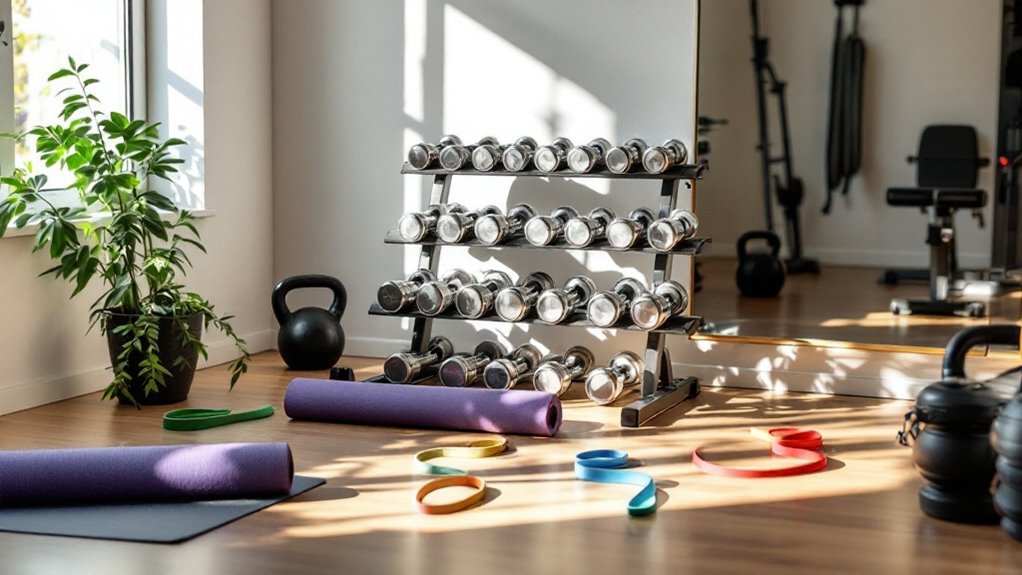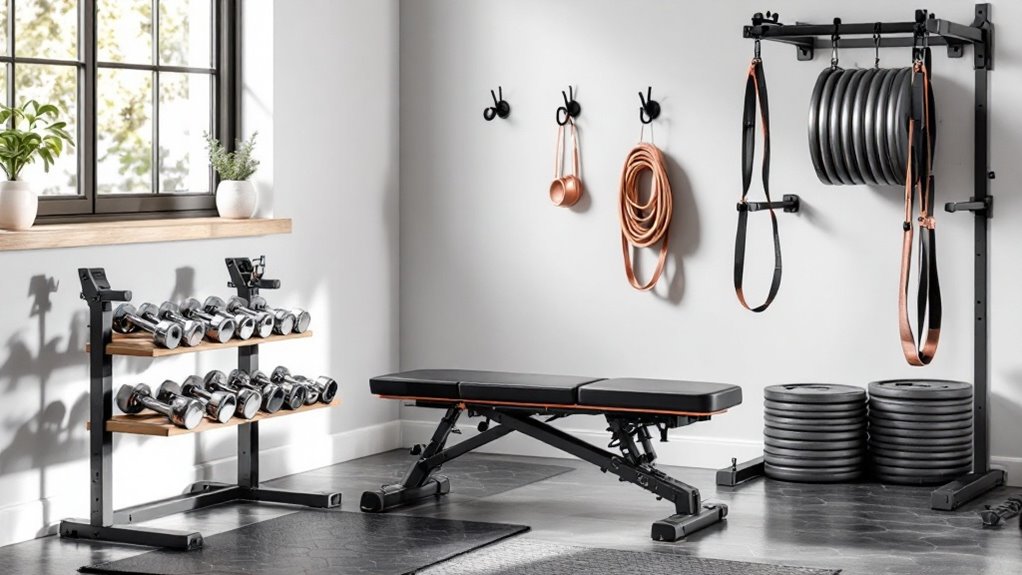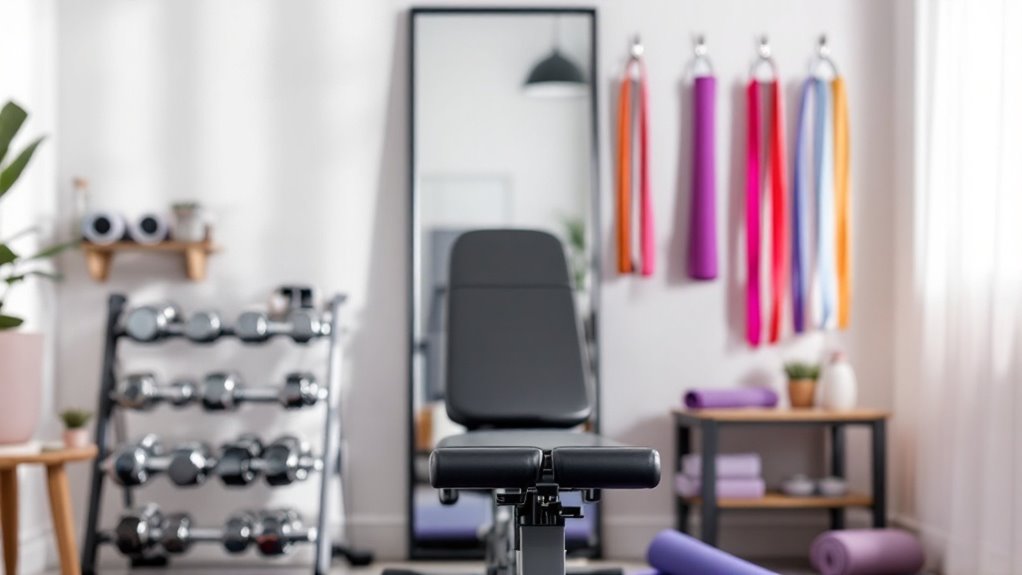Weight Training Plan for Women

Weight training provides women with a structured path to build strength, boost metabolism, and transform their bodies. A three-day split routine targeting different muscle groups allows proper recovery while maintaining momentum. Essential equipment includes dumbbells, barbells, and adjustable benches, with proper form being paramount for results. Progressive overload and consistent tracking guarantee steady gains, while attention to technique prevents injury. The journey to strength reveals countless benefits along the way.
Key Takeaways
- Start with a three-day split routine focusing on upper body, pulling exercises, and lower body on alternating days.
- Begin with bodyweight exercises to master proper form before progressing to weighted movements.
- Focus on compound exercises like squats, deadlifts, and bench presses to maximize muscle development and metabolism boost.
- Track progress using a workout log while gradually increasing weights to ensure steady strength gains.
- Include proper rest between workouts and maintain form consistency to prevent injury and optimize results.
Understanding Weight Training Benefits for Women

While many women have traditionally focused on cardio exercises for their fitness routines, weight training offers a powerful array of physical and mental benefits that can transform both body and mind.
Weight training increases bone density, preventing osteoporosis and improving posture. It boosts metabolism through increased muscle mass, leading to more efficient fat burning even at rest.
Weight training strengthens bones and revs up metabolism, transforming your body into a 24/7 calorie-burning powerhouse while building better posture.
The discipline develops mental toughness and confidence that extends beyond the gym.
Studies show women who incorporate strength training experience reduced anxiety, improved sleep quality, and enhanced hormone regulation.
The myth of "bulking up" has been debunked – women naturally lack the testosterone levels required for significant muscle bulk.
Following a structured progressive overload approach ensures steady strength gains while maintaining proper form and technique.
Essential Equipment and Gym Setup

Before starting a weight training journey, women need access to proper equipment and an organized training environment that supports their fitness goals. Essential items include dumbbells, barbells, weight plates, and adjustable benches for fundamental exercises.
A dedicated area for weight training should feature non-slip flooring, proper lighting, and mirrors for form checks. Key equipment includes squat racks, cable machines, and resistance bands for versatile workout options.
For home gyms, compact alternatives like adjustable dumbbells and foldable benches optimize space efficiency. Storage solutions keep equipment organized and accessible, creating a motivating environment that encourages consistent training habits. Creating a personalized fitness routine ensures the selected equipment matches your specific training goals and experience level.
Building Your Weekly Training Schedule

Success in weight training starts with a well-structured weekly schedule that balances exercise frequency, intensity, and recovery time.
For beginners, a three-day split routine allows adequate muscle recovery while maintaining steady progress.
Monday focuses on upper body pushing movements, Wednesday targets pulling exercises and core work, while Friday emphasizes lower body strength. This structure creates a 48-hour recovery window between sessions.
Start with 45-minute workouts, gradually increasing duration and intensity as strength builds.
Track progress using a workout log to monitor improvements in form, weight, and endurance. Remember: consistency trumps perfection in the early stages.
Focus on mastering compound exercises like squats and bench presses before attempting more complex movements.
Proper Form and Exercise Techniques

Proper form serves as the foundation for every successful weight training journey. Each exercise demands strict attention to posture, breathing, and controlled movement to enhance results while preventing injury.
Like a soldier's precise rifle handling, proper technique requires discipline and focus.
Key form principles include maintaining a neutral spine, engaging core muscles, and controlling movement through full ranges of motion. Women should master basic movement patterns before increasing weights.
Recording form checks via video helps identify areas for improvement.
When executing exercises, imagine creating straight lines and smooth arcs with the body, similar to a well-choreographed dance routine.
Progressive overload techniques can only be safely implemented once proper form becomes second nature.
Frequently Asked Questions
Should I Train During My Menstrual Cycle?
Training during menstruation is absolutely safe and can be beneficial.
Hormonal fluctuations affect performance differently across the cycle – some athletes even set personal records during menstruation.
Listen to your body, adjust intensity as needed, and maintain consistency.
Iron levels may be lower, so focus on iron-rich foods.
The key is adapting the workout intensity while staying committed to training goals.
Can Weight Training Help Reduce Menopause Symptoms?
Like a cooling breeze on a hot summer day, weight training can provide significant relief from menopause symptoms.
Research shows that resistance training helps maintain bone density, reduces hot flashes, improves sleep quality, and manages weight fluctuations.
Regular strength training also boosts mood by increasing endorphin production, while building lean muscle mass helps combat the natural decline in metabolism during menopause.
How Long Before I Start Seeing Visible Muscle Definition?
Visible muscle definition typically emerges within 8-12 weeks of consistent strength training, proper nutrition, and adequate recovery.
Results vary based on genetics, body fat percentage, and training intensity. Someone starting with higher body fat may need to focus on fat loss alongside muscle building.
Key factors include maintaining a protein-rich diet, progressive overload in workouts, and getting 7-8 hours of sleep nightly for ideal muscle development.
Will Protein Supplements Make Me Look Too Bulky?
Just as a sprinter doesn't become a bodybuilder by wearing running shoes, protein supplements alone won't create excessive muscle bulk.
The body requires specific conditions – including intense training, caloric surplus, and genetic factors – to build significant muscle mass. Protein supplements simply provide the building blocks for muscle recovery and maintenance.
Without intentional training for size, supplements primarily support lean muscle definition and healthy body composition.
What Should I Eat Before and After Weight Training Sessions?
Pre-workout nutrition should include complex carbs and lean protein 2-3 hours before training – like oatmeal with banana and eggs.
A light snack 30 minutes before can include fruit or toast.
Post-workout, consume protein and fast-digesting carbs within 30 minutes – protein shake with fruit, or chicken with rice.
This timing enhances energy during workouts and supports muscle recovery afterward.
Final Thoughts
Like a sculptor revealing beauty from raw stone, weight training transforms both body and mind. Women who embrace strength training discover newfound confidence, increased metabolism, and improved physical capability. With proper form, consistent training schedules, and the right equipment, any woman can achieve her fitness goals. This fundamental approach to fitness isn't just about lifting weights—it's about lifting limitations and redefining personal potential.


